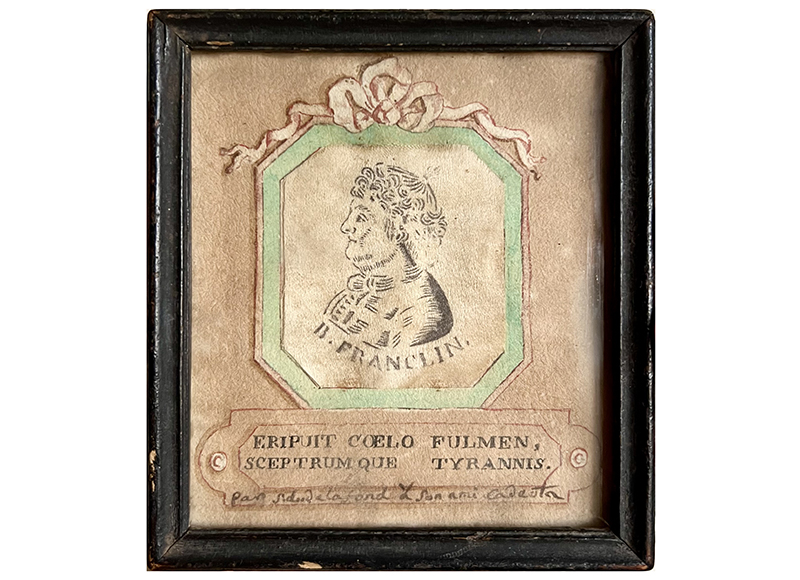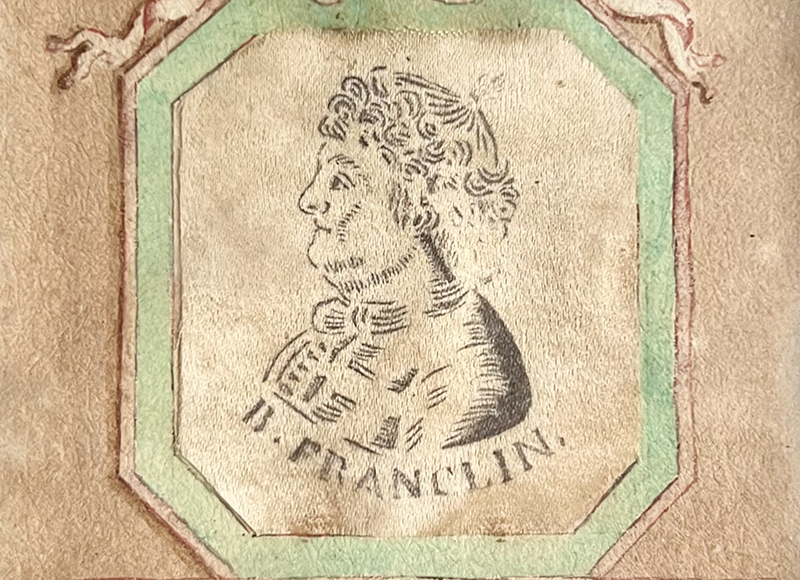- HOME
- INVENTORY
- GALLERY
- BOOKS
- CATALOGS
- ABOUT & MORE
- CONTACT
Contact Us
Portrait-Miniature of Benjamin Franklin (1706-1790)
Joseph-Aignan Sigaud de Lafond (1730-1810)
Satin by means of “electric spark,” paper, ink
Circa: 1785-1790
Size: 3 3/4" x 4 1/8"
CLICK HERE to see and Instagram Reel discussing this work.
An important and historically unique portratit of Benjamin Franklin done by means of an experimental electrical process.
With Franklin putting lightning in a bottle, electricity was one the most experimented forms of science in the Age of Enlightenment. Already revered as a Scientist worldwide, Franklin served as a diplomat to France following the American Revolution where he was known as “The Great American.”
Joseph-Aignan Sigaud de Lafond was a well known professor of experimental physics in Paris and likely met Franklin. Sigaud de LaFond was known for his demonstrations and books on electricity. In a 1786 book on experimental physics, the author Edme-Gilles Guyot, explained precisely how to create a portrait-miniature with electricity and gold leaf.
This portrait-miniature was likely made in a demonstration by Sigaud de Lafond in honor of Franklin for his contributions to the study of electricity. Fittingly the script below reads, Eripuit coelo fulmen sceptrumque tyrannis, or “He snatched lightning from the sky and scepters from tyrants,” which was said of Franklin in 1778 by the French statesman, Anne Robert Jacques Turgot. The portrait appears to be based on Nini’s, 1777 medallion portrait which was ubiquitous throughout Paris.
The electric portrait was tedious, temperamental and offered no real advantage over intaglio printing, thus the method was likely limited to controlled experiments and not something commercially viable. As far as I tell this is the only extant example of this electrical process ... and it’s of Franklin!!!
Franklin's role in the American Revolution cannot be overstated and it is arguable that we would not have succeeded if not for Franklin's role. From the Department of State's website, The Office of the Historian, the following is referenced, "Franklin served from 1776 to 1778 on a commission to France charged with the critical task of gaining French support for American independence. French aristocrats and intellectuals embraced Franklin as the personification of the New World Enlightenment. His likeness appeared on medallions, rings, watches, and snuffboxes, and fashionable ladies adopted the "coiffure a la Franklin" in imitation of the fur cap he wore instead of a wig. His popularity and diplomatic skill—along with the first American battlefield success at Saratoga—convinced France to recognize American independence and conclude an alliance with the thirteen states in 1778. Franklin presented his credentials to the French court in 1779, becoming the first American Minister (the eighteenth century American equivalent of Ambassador) to be received by a foreign government. Franklin’s home in Passy, just outside Paris, became the center of American diplomacy in Europe. When Thomas Jefferson succeeded Franklin in 1785, French Foreign Minister Vergennes asked: “It is you who replace Dr. Franklin?” Jefferson replied, 'No one can replace him, Sir; I am only his successor.'"
Provenance: Paris, France Collection
HIGH RESOLUTION IMAGES AVAILABLE.
Condition: Commensurate with age, untouched and in a remarkable state of originality.
Price: please inquire

ALL ITEMS GUARANTEED AS REPRESENTED
STEVEN S. POWERS • 53 STANTON ST, NY, NY 10002 • 917-518-0809 • email: steve@stevenspowers.com • © all rights reserved






